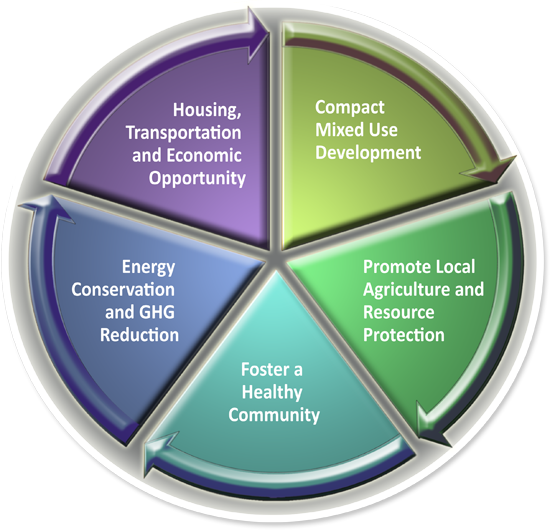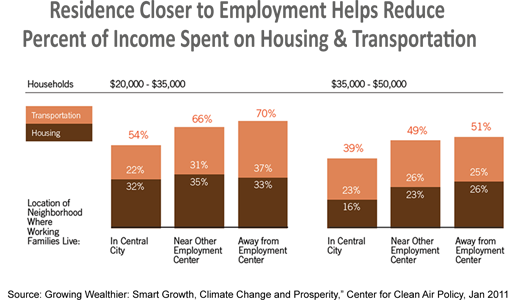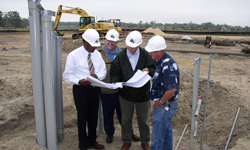Key Principles and Benefits:

Housing, Transportation and Economic Opportunity
Transportation Mobility Element
The Plan promotes more mobility options and responds to changing demographics and emerging markets by linking long-range multimodal transportation plans with standards and incentives for higher density, mixed-use development along planned transit corridors within the existing urban area.

This approach provides for non-residential employment-based land uses proximate to residential
areas, reduces trip lengths, and can also reduce the transportation component of housing costs. (See chart)

Economic Element

The Plan’s Economic Element addresses workforce training opportunities, promotion of local businesses and targeted industries, tourism and other strategies and incentives to diversify the local economy and provide a range of employment opportunities, including in the emerging ‘Green Jobs’ sector.
Housing Element

The Plan promotes affordable housing throughout the County through flexible lot sizes, unit types and provision for accessory dwelling units. The Housing Element supports programs for homeownership and rehabilition of existing housing stock.
Compact Mixed Use Development
Future Land Use Element
 The Future Land Use Element focuses urban development within a defined urban growth
boundary (Urban Cluster) to maximize efficient use of land, separate urban and
rural areas, and protect agricultural areas and natural resources.
The Future Land Use Element focuses urban development within a defined urban growth
boundary (Urban Cluster) to maximize efficient use of land, separate urban and
rural areas, and protect agricultural areas and natural resources.
The Plan promotes the continued concentration of growth in the Urban Cluster
by providing incentives for new development located within urban residential land use
categories to be designed as Traditional Neighborhood Development (TND) or Transit
Oriented Development (TOD) with higher transit-supportive densities and mixed uses.
Cottage Neighborhoods, groups of smaller homes built around a common green space, offer
opportunities for creative, diverse and high quality infill development within the Urban Cluster,
and more efficient use of land through density bonuses.
 About 90% of new residential development in unincorporated Alachua County has occurred
within the Urban Cluster, which comprises only 8% of the unincorporated area, over the past
10 years. Agricultural activities are promoted in the rural area, and there are policies and incentives for
clustered development in the rural area; larger new developments are required to cluster to protect open
space for continued agricultural or conservation uses and provide for more efficient use of land.
About 90% of new residential development in unincorporated Alachua County has occurred
within the Urban Cluster, which comprises only 8% of the unincorporated area, over the past
10 years. Agricultural activities are promoted in the rural area, and there are policies and incentives for
clustered development in the rural area; larger new developments are required to cluster to protect open
space for continued agricultural or conservation uses and provide for more efficient use of land.

Promote Local Agriculture and Resource Protection
Conservation and Open Space Element
 The Plan promotes local food
production and establishment of
community infrastructure to
support a local food system, such
as processing facilities and local
farmers markets.
The Plan promotes local food
production and establishment of
community infrastructure to
support a local food system, such
as processing facilities and local
farmers markets.
 Policies promote
urban agricultural uses such as
residential chicken keeping,
community gardens and edible
landscapes, as part of the effort
to reduce community greenhouse
gas emissions by shortening
distances to bring food to local
markets.
The Plan protects the diverse
range of natural resources and
agricultural and silvicultural lands
with policies promoting
agritourism and ecotourism as
well as policies promoting more
sustainable practices including
reduced use of synthetic fertilizers.
Policies protect air and water
quality, species diversity, and
identify six primary conservation
areas and methods for protection,
including wetlands, surface
waters, 100-year floodplains,
listed species habitat, significant
geologic features and strategic
ecosystems.
Policies promote
urban agricultural uses such as
residential chicken keeping,
community gardens and edible
landscapes, as part of the effort
to reduce community greenhouse
gas emissions by shortening
distances to bring food to local
markets.
The Plan protects the diverse
range of natural resources and
agricultural and silvicultural lands
with policies promoting
agritourism and ecotourism as
well as policies promoting more
sustainable practices including
reduced use of synthetic fertilizers.
Policies protect air and water
quality, species diversity, and
identify six primary conservation
areas and methods for protection,
including wetlands, surface
waters, 100-year floodplains,
listed species habitat, significant
geologic features and strategic
ecosystems.
The Plan promotes the use of Low Impact Design (LID) storm- water management techniques to protect water quality and for efficient stormwater management. The Plan identifies and prioritizes maintenance of ecologically functional linkages between ecological corridor core areas through various programs and activities.
Foster a Healthy Community
Community Health Element

 The Community Health Element focuses on public/private partnerships, including local government, Alachua County Health
Department, higher education institutions, and the Alachua County School Board, to preserve the health of County residents by
facilitating health care delivery, improved equity and livability of the community, and opportunities for active living.
The Community Health Element focuses on public/private partnerships, including local government, Alachua County Health
Department, higher education institutions, and the Alachua County School Board, to preserve the health of County residents by
facilitating health care delivery, improved equity and livability of the community, and opportunities for active living.
Energy Conservation and Greenhouse Gas Reduction
Energy Element


The Energy Element sets a long term goal for reduction in community greenhouse gas emissions through strategies related to conservation, improved efficiency, and promotion of alternative and renewable energy. Objectives and policies in eight areas include: reduction in energy consumption and greenhouse gas emissions; the built environment; energy efficient land use; energy efficient transportation systems; initiatives by and within County Government; renewable energy; solid waste strategies both to reduce solid waste disposal and to promote products made from recycled materials; and public outreach and education. The Alachua County Courthouse (right) was built to LEED Silver Certification standards.
